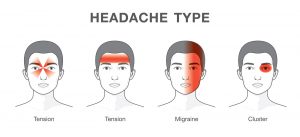
The aim of this study was to compare patients with chronic migraine (CM) and chronic temporomandibular disorders (TMD) on disability, pain, and fear avoidance factors and to associate these variables within groups. A total of 50 patients with CM and 51 patients with chronic TMD, classified by international criteria classifications were included in the study. The variables evaluated included pain intensity (visual analog scale [VAS]), neck disability (NDI), craniofacial pain and disability (CF-PDI), headache impact (HIT-6), pain catastrophizing (PCS), and kinesiophobia (TSK-11).
Statistically significant differences were found between the CM group and the chronic TMD group in CF-PDI ( P < 0.001), PCS ( P = 0.03), and HIT-6 ( P < 0.001); however, there were no differences between the CM group and the VAS, NDI, and TSK-11 groups ( P > 0.05). For the chronic TMD group, the combination of NDI and TSK-11 was a significant covariate model of CF-PDI (adjusted R 2 = 0.34). In the CM group, the regression model showed that NDI was a significant predictive factor for HIT-6 (adjusted R 2 = 0.19).
Differences between the CM group and the chronic TMD group were found in craniofacial pain and disability, pain catastrophizing, and headache impact, but they were similar for pain intensity, neck disability, and kinesiophobia. Neck disability and kinesiophobia were covariates of craniofacial pain and disability (34% of variance) for chronic TMD. In the CM group, neck disability was a predictive factor for headache impact (19.3% of variance).
No comments:
Post a Comment